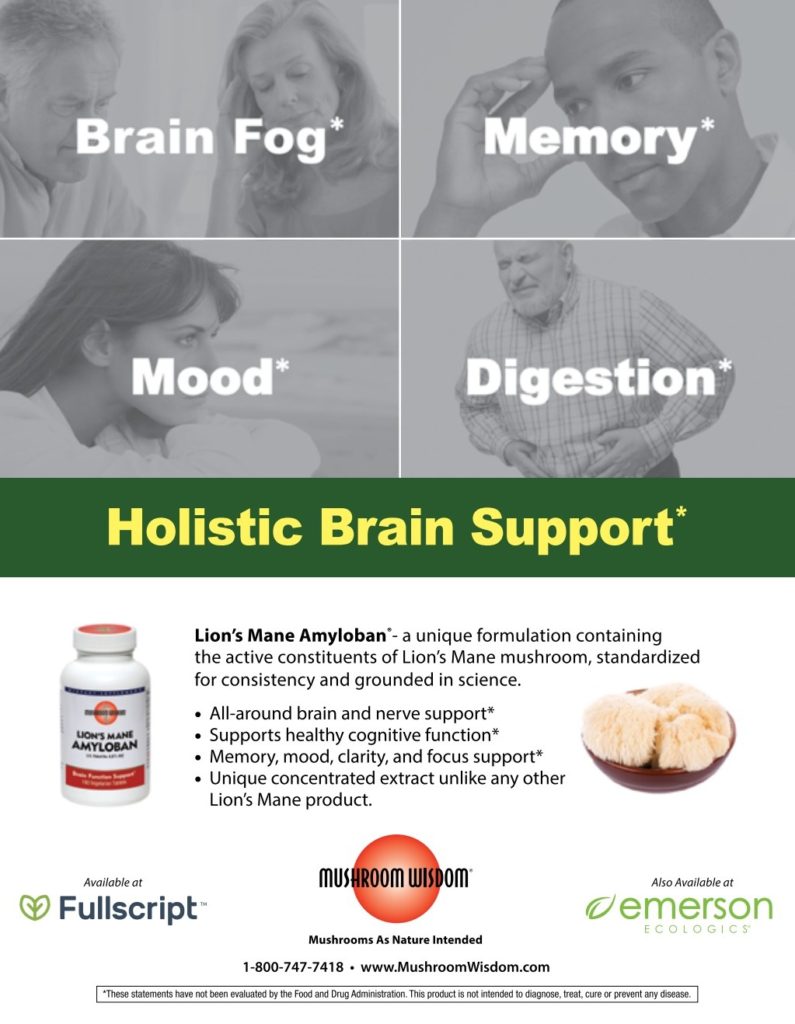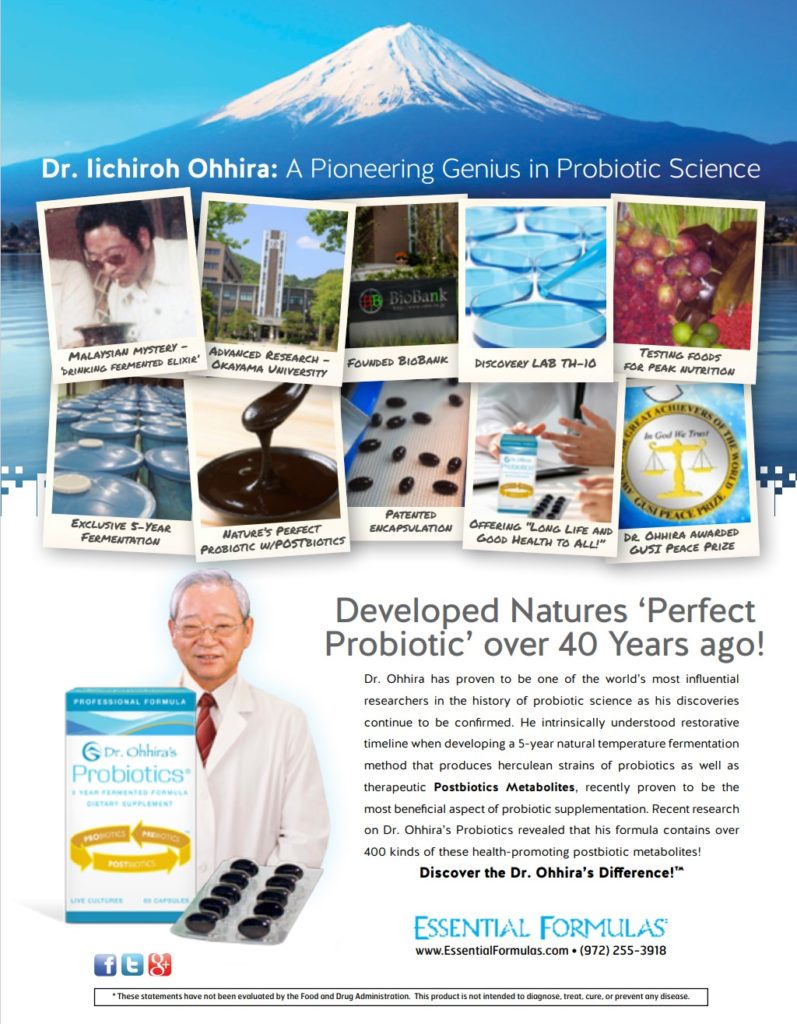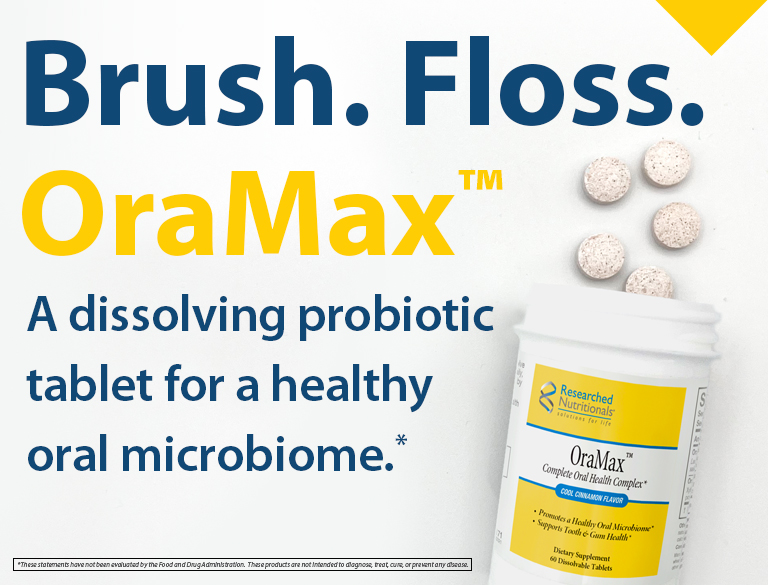by Michael Traub, ND, FABNO
and Miranda LaBant, ND, MSc
Overview
The healing power of mushrooms has been known for centuries. Having secured a rich history in traditional Chinese medicine, mushrooms have been prescribed and used for many ailments. In this era of health and wellness, medicinal mushrooms are gaining popularity as a functional food and medicine fortheir cancer-fighting and cancer-preventing properties. This article reviews the evidence for use of medicinal mushrooms in cancer care.
The therapeutic uses of medicinal mushrooms are referred to as mycotherapy. Mycotherapy is used in cancer care during surgery, chemotherapy, and radiotherapy to support immune function, as well as following conventional treatments to prevent recurrence. There are several primary mechanisms that have been identified. Research has demonstrated antineoplastic properties, regulation of tumor genes, decrease in tumor angiogenesis, increase in malignant-cell phagocytosis, chemo-sensitization, and protection against chemotherapy-induced bone marrow suppression.
One of the active compounds responsible for the immune-enhancing effects of mushrooms is in the form of complex polysaccharides known as β -glucans. Glucans can be extracted from cell walls of yeast, oat, barley, seaweeds, algae, and bacteria, as well as fungi. Fungal polysaccharides include chitin, cellulose, β-glucans (e.g. lentinan, grifolan, krestin [PSK]) and a-glucans (e.g. glycogen), or polysaccharide-protein complexes.1 β-glucans are principally found in the fruit body of various types of mushrooms.
Physical and Chemical Properties of β-Glucans
All β-glucans are glucose polymers linked together by a 1→ 3 linear β-glycosidic chain core, and they differ from each other by their length and branching structures.2 Beta glucans can form large cylindrical molecules containing up to 250,000 glucose units. The length and branches of the β-glucan from various fungi are widely different. The immune functions of β-glucans appear to be dependent on their conformational complexity.3 It has been suggested that a higher degree of structural complexity is associated with a more potent immunomodulatory and anti-cancer effect.
Trametes (Coriolus) versicolor: Turkey Tail
Trametes versicolor (formerly called Coriolus versicolor) is one of the most well-studied medicinal mushrooms. The common name “turkey tail” comes from the banding pattern on the fruiting bodies that resembles (in miniature, of course) the tail of a strutting turkey. The colors of the bands can be quite variable, depending on the genetics of the organism and its environment. Most of the bands are dark to light brown in color, alternating with light-colored bands of white to tan, with still more bands of blue, orange, maroon, and other. They can be strikingly beautiful, and are among the most easily found fungi. The species has a widespread distribution, having been found in nearly every state in the United States and in most other countries.
Trametes contains polysaccharide krestin (PSK) and polysaccharide peptide (PSP). These are soluble in water, not ethanol, which addresses the importance of using the proper extraction method for mushrooms. Trametes is the most extensively researched of all medicinal mushrooms with large scale clinical trials on PSK and PSP showing impressive results in a variety of cancers including gastric, esophageal, lung, breast, and colorectal. PSK boosts NK cell production, improves side effects from chemotherapy and radiation therapy, and enhances survival in cancers of the stomach, colon, uterus, and lung in combination with conventional treatment. PSP enhances immune status in patients with cancer of the lung, cervix, ovary, stomach, and esophagus when used as adjuvant to chemotherapy.
In a systematic review and meta-analysis from 13 randomized, placebo-controlled, double blind trials, a significant survival advantage in various cancers was found with Trametes compared with conventional treatment alone. Patients receiving Trametes had a 9% absolute reduction in five-year mortality, resulting in one additional patient alive for every 11 patients treated. Patients with breast, colorectal, and gastric cancer who had been treated with chemotherapy showed the best results in combination with Trametes in five-year survival.4
Seely and colleagues at the Ottawa Integrative Cancer Center published a systematic review in May 2015 of Trametes showing a positive impact on various survival measures in lung cancer.5
While there is not enough evidence to support using Trametes alone for cancer treatment, there is abundant evidence showing its efficacy as adjuvant therapy. Particularly in cases of breast, gynecological, lung, colorectal, and gastric cancer, this mushroom should be a component of the treatment plan, both during and after conventional treatments.
Ganoderma lucidum: Reishi
Ganoderma lucidum, an oriental fungus, has a long history for use for promoting health and longevity in China, Japan, and other Asian countries. It is a large, dark mushroom with a glossy exterior and a woody texture. The Latin word lucidus means “shiny” or “brilliant” and refers to the varnished appearance of the surface of the mushroom.
A Cochrane review of randomized controlled trials using Ganoderma as cancer treatment in all types and stages of cancer was published in 2016.6 Ganoderma in cancer patients had a positive impact on quality of life, as significantly more subjects achieved an increase in performance status after an intervention in the Ganoderma group than in control groups (P < 0.01). The meta-analysis results also reported that patients who had been given Ganoderma with chemo/radiotherapy were 50% more likely to respond positively compared to chemo/radiotherapy alone (P = 0.02).
In a 2003 publication, 30 advanced-stage cancer patients treated with 1800 mg Ganoderma extract three times daily for 12 weeks showed significant increase in NK activity compared to baseline.7 There is not sufficient evidence to justify the use of Ganderma as a first line treatment for cancer. However, Ganoderma administered as an alternative adjunct to conventional treatment is promising, considering its potential to enhance tumor response and stimulate host immunity.
Grifola frondosa: Maitake
Grifola grows in clusters at the base of trees, particularly oaks. Its common name in English is ram’s head or sheep’s head. In a 2009 study, 34 postmenopausal women with stage I, II or III breast cancer, who were free of disease after initial treatment, were given Grifola in escalating doses over three weeks and showed significantly increased NK cell counts compared to baseline.8
Grifola has also been used to prevent postoperative recurrence of bladder cancer. Patients receiving Grifola had a lower recurrence rate than other patients who instead received either BCG, mitomycin C, thiotepa, or placebo.9 It should be noted, however, that prevention of recurrence is only 24% with afterloading brachytherapy.
Lentinula edodes: Shiitake
Lentinula is an edible mushroom native to East Asia, which is cultivated and consumed in many Asian countries. Seven cancer patients undergoing postoperative adjuvant or neoadjuvant chemotherapy for breast or gastrointestinal cancer were given Lentinula 1800mg/day for four weeks. They showed improvement in quality of life and NK cell activity.10
Active hexose correlated compound (AHCC) is a generic term to describe a plant polysaccharide extracted from a liquid culture of basidiomycetous mycelia of Lentinula edodes. AHCC has immune-stimulating activity, anticancer activity, cancer-preventive actions and can prevent side effects during cancer chemotherapy.11 AHCC has also been shown to improve prognosis in post-operative hepatocellular carcinoma patients.12
Inonotus obliquus: Chaga
Inonotus is parasitic on birch and other trees. The conk has the appearance of burnt charcoal, due to massive amounts of melanin. There are no published human trials on Inonotus. Cell studies have shown anti-cancer effects for glioma, melanoma, breast, lung, liver, and colorectal cancer, and in mouse models of sarcoma, lung, stomach, breast and cervical cancer.13
Ophiocordyceps sinensis: Cordyceps
Ophiocordyceps is not a mushroom but a fungus that parasitizes larvae of ghost moths and produces a fruiting body. The fungus germinates in the living larvae, kills, and mummifies it. Once mummified, a stalk-like fruiting body emerges from the corpse. It is known colloquially as caterpillar fungus.
Ophiocordyceps has specifically demonstrated prolonged survival in patients with hepatocellular carcinoma when included in combination with 12 other natural medicines.14
Hericium erinaeus: Lion’s Mane
| Cancers | Indicated Mushrooms | Reference |
| Breast | Trametes, Ganoderma, Agaricus sylvaticus, Grifolia | Torkelson et al, 2012 Gonul et al, 2015 |
| Colorectal | Trametes, Ganoderma, Grifolia | Ohwada, et al, 2006 |
| Gastric | Trametes | Eliza et al, 2012 |
| GYN Hepatocellular Leukemia Lymphoma | Ganoderma Agaricus, Ganoderma, Lentinula Agaricus, Ganoderma, Trametes Cordyceps | Supraser, et al, 2014 Li et al, 2015 Matsui 2002 Hsieh et al, 2013 |
| Lung Prostate Advanced Cancer | Trametes, Ganoderma, Cordyceps Trametes Ganoderma | Fritz, et al, 2015 Wenner et al, 2012 Gao, et al, 2003 |
Hericium is one of the more interesting-looking types of mushrooms. In place of the common mushroom cap is a large clump of spine-like structures a few millimeters long. Hericium has demonstrated anti-cancer potential against human gastrointestinal cancers in cell and mouse models.15
Besides anti-cancer effects, Hericium also exhibits neuro-regenerative effects and may be a reasonable choice for patients during or post-chemotherapy for chemotherapy-induced peripheral neuropathy.16
See Table 1, above, for a summary of research findings on medicinal mushrooms for various cancers.
Fruiting Body Versus Mycelial Extracts
It was previously thought that mycelial extracts might be more potent and cost-effective than the extracts of mushroom fruiting bodies. This concept has not stood up to scrutiny.17 The active constituents in mushrooms consist principally of beta-D-glucans, and secondarily of triterpenoids and ergosterol. Starch is utilized as an indicator of adulteration. Analytical methods that quantify the active compounds demonstrate that mushroom fruiting bodies are high in beta-D-glucans and very low in starch. Mycelium produced on cereal grains is low in beta-D-glucans and high in starch.
Ergosterol analysis shows the actual amount of fungal material in the products. Ergosterol also has antitumor and antioxidant properties18 and is a precursor to vitamin D2. When exposed to sunlight (UVB), mushrooms as well as human skin convert ergosterol to ergocalciferol (provitamin D2).19 Mushrooms grown on natural substrates contain precursors that yield secondary metabolites such as triterpenoids whereas mycelium produced on cereal grains lack such precursors. In addition to playing a complementary role with beta-glucans in immune system activation, triterpenoid actions are also hepatoprotective, lipid lowering, antioxidant, anti-inflammatory, and inhibit histamine release.20 The triter-penoids are lipids, e.g. ganoderic acids, responsible for the bitter taste of reishi and this bitterness can be used as a quick method of determining the quality of a reishi product.
Beta-D-glucans are a polysaccharide structural component of the cell walls of mushrooms, mycelium, yeast, certain bacteria, and cereal grains. The unique structural differences of beta-D-glucans determine medicinal activity and explain why fungal beta-glucans are more active than cereal beta-glucans.1
Beta-glucans activate or potentiate both innate and adaptive immune responses and have been described as “biological response modifiers” and “host defense” potentiators. Beta-glucans increase the number and functional activity of macrophages, natural killer cells, and other subclasses of T-cells. Beta-glucans are not degraded by digestive enzymes and pass intact into the small intestine where they activate specific beta-glucan receptor sites.18 The immunological potentiation is not only anti-cancer but also increases protection against viral, bacterial, fungal and parasitic infections.21 Beta glucans and protein-bound beta glucans are responsible for the medicinal properties of mushrooms and mycelia. Lentinan, a pure (1→3)beta- D-glucan, is extracted from shiitake mushroom Lentinus edodes. PSK and PSP are protein-bound beta-glucans derived from the fermentation of Trametes mycelium.
Mushroom Synergy
Combinations of mushroom extracts may exhibit synergistic effects. A study has shown that Trametes and Ganoderma were more active in inducing apoptosis of leukemia cells compared to Trametes alone. Interestingly, the study also found that ethanolic extracts were more anti-proliferative than aqueous extracts.22
References
- Vannucci L, et al. Immunostimulatory properties and antitumor activities of glucans (review). Int J Onc. 2013;43: 357‐364.
- Stone B, Clarke A. Chemistry and biology of (1,3)‐D‐glucans. 1992, Victoria, Australia:La Trobe University Press
- Chi‐fung Chun G, et al. The effects of B‐glucan on human immune and cancer cells. J Hema Onc. 2009. 2:25.
- Eliza W, et al. Efficacy of Yun Zhi (Coriolus versicolor) on survival in cancer patients: systematic review and meta‐analysis. Recent Pat Inflamm allergy drug discov 2012 Jan; 6 (1): 78‐8
- Frizz H, et al. Polysaccharide K and Coriolus versicolor extracts for lung cancer: A systematic review. Integr Cancer Ther. 2015 May; 14 (3):201‐11
- Jin X, et al. Ganoderma lucidum (Reishi mushroom) for cancer treatment. Cochrane Database of Systematic Reviews 2016, Issue 4. Art. No.:CD007731.
- Gao Y, et al. Effects of ganopoly (a Ganoderma lucidum polysaccharide extract) on the immune functions in advanced‐stage cancer patients. Immunol Invest. 2003. Aug; 32 (3): 201‐15
- Deng G, et al. A phase I/II trial of a polysaccharide extract from Grifolia frondosa (Miatake mushroom) in breast cancer patients: immunological effects. J Cancer Res Clin Oncol. 2009. Sep; 135(9): 1215‐21
- Yang D, et al. Prevention of postoperative recurrence of bladder cancer: a clinical study. Zhonghua Wai Ke Za Xhi. 1999 Aug; 37(8): 464‐465
- Yamaguchi Y, et al. Efficacy and safety of orally administered Lentiula edodes mycelia extract for patients undergoing cancer chemotherapy: a pilot study. Am J Chin Med. 2011; 39(3): 451‐459
- Shigama K, et al. Alleviating effect of active hexose correlated compound (AHCC) for anticancer drug‐induced side effects in non‐tumor‐bearing mice. J Exp Ther Oncol. 2009;8:43‐51
- Matsui K, et al. Improved prognosis of postoperative hepatocellular carcinoma patients when treated with functional foods: a prospective cohort study. J Hepatol 2002;37:78‐86.
- Kang JH, et al. Ergosterol peroxide from Chaga mushroom (Inonotus obliquus) exhibits anti‐cancer activity by down‐regulation of the β‐catenin pathway in colorectal cancer. J Ethnopharmacol. 2015 Sep 15;173:303‐12.
- Niwa Y, et al. Evidence that naturopathic therapy including Cordyceps sinensis prolongs survival in patients with hepatocellular carcinoma. Integr Cancer Ther. 2013. Jan; 12(1): 50‐68
- Li G, et al. Anticancer potential of Hericium erinaceus extracts against human gastrointestinal cancer. J Ethnopharmacol. 2014 Apr 28;153(2): 521‐30
- Wong KH, et al. Neuroregenerative potential of lion’s mane mushroom, Hericium erinaceus (Bull.: Fr.) Pers. (higher Basidiomycetes), in the treatment of peripheral nerve injury (review). Int J Med Mushrooms. 2012;14(5):427‐46.
- Nammex‐organic medicinal mushroom extracts. Date retrieved: 2014 http://www.nammex.com/organic‐mushroom‐extracts/
- Borchers A, et al. Mushrooms, tumors, and immunity: an update. Exp Biol Med. 2004 229: 393‐406
- Kamweru PK, Tindibale EL. Vitamin D and Vitamin D from Ultraviolet‐Irradiated Mushrooms (Review). Int J Med Mushrooms. 2016;18(3):205‐14
- Dudhgaonkar S, et al. Supression of the inflammatory response by triterpenes isolated from the mushroom Ganoderma lucidum. Int Immunopharm. 2009; 9:1272‐1280
- Gunde‐Cinerman N. Medicinal Value of the Genus Pleurotus (Fr.) P. Karst (Agaricales s.1., Basidiomycetes). Int J Med Mushrooms. 1999;1:69‐80
- Hsieh T, Wu J. Regulation of cell cycle transition and induction of apoptosis in HL‐60 leukemia cells by the combination of Coriolus versicolor and Ganoderma lucidum. Int J Mol Med. 2013 32(1): 251‐7

Dr. Traub received a BS in biological sciences from the University of California, Irvine, in 1976, graduated from NCNM in 1981, and completed a two-year residency there in family practice and homeopathy. He is a diplomate of the Homeopathic Academy of Naturopathic Physicians (HANP) and a fellow of the American Board of Naturopathic Oncology (ABNO), and served on the ABNO Board of Examiners for seven years. Dr. Traub served as AANP President from 2001-2003 and, in 2006, received the AANP Physician of the Year Award. He is the author of Dermatological Diagnosis and Integrative Therapeutics. He serves on the advisory boards of Nutritional Fundamentals for Health, Gaia Herbs, Nordic Naturals, Dermveda, and Kamedis. Dr. Traub has been medical director of Lokahi Health Center in Kailua Kona, Hawaii, since 1986 and is now medical director of Hawaii Integrative Oncology.
Dr. LaBant graduated from National University of the Health Sciences in Lombard, Illinois, in December 2016. This Spring, she began her two-year naturopathic oncology residency program at Lokahi Health Center under the direction of Michael Traub, ND, in Kailua Kona, Hawaii. She was born and raised in northeast Ohio, where she completed her Masters of Health Sciences from Cleveland State University. Dr. LaBant is passionate about endocrine and gastrointestinal health, integrative oncology, preventive health and wellness, as well as the use of botanical medicine, and biotherapeutic drainage therapies. In her time outside of the office, she can be found exploring and hiking the many landscapes of the Big Island.












